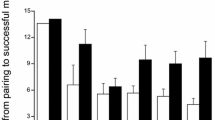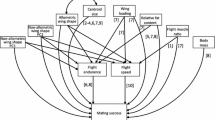Abstract
The cricket, Gryllus rubens (Orthoptera, Gryllidae), exists in natural populations as either a fully-winged (LW), flight-capable morph or as a short-winged (SW) morph that cannot fly. The SW morph is substantially more fecund than the LW morph. In this study we report on the physiological basis of this trade-off between flight capability and fecundity. Results from gravimetric feeding trials indicate that LW and SW morphs are equivalent in their consumption and digestion of food. However, during the adult stage, the LW morph is less efficient in converting assimilated nutrients into biomass. This may be a consequence of the respired loss of assimilated nutrients due to the maintenance of functional flight muscles in the LW morph. In both morphs the gross biomass devoted to flight muscles does not change significantly during the first 14 days of adult growth while there is a significant biomass gain in ovarian tissue mass during the same period. SW morphs have vestigial flight muscles and gain substantially more ovarian mass relative to the LW morphs. These data are consistent with a trade-off between flight muscle maintenance in the LW morph and ovarian growth in the SW form. This is the first evidence for a life-history trade-off that has a physiological basis which is limited to the allocation of acquired and assimilated nutrients within the organism.
Similar content being viewed by others
References
Andersen NM (1973) Seasonal polymorphism and developmental changes in organs of flight and reproduction in bivoltine pond-skaters. Entomol Scand 4: 1–20
Ballinger RE, Droge D, Jones SM (1981) Reproduction in a Nebraska Sandhills population of northern prairic lizard Sceleroporus undulatus garmanii. Am Midl Nat 106: 157–164
Beenakkers AM, Van der Horst DJ, Van Marrewijk WJA (1981) Role of lipids in energy metabolism. In: Downer RGH (ed) Energy metabolism in insects. Plenum Press, New York
Calow P (1979) The cost of reproduction: A physiological approach. Biol Rev 54: 23–40
Fisher RA (1930) The genetical theory of natural selection. Clarendon Press, Oxford
Hardie J, Lees AD (1985) Endocrine control of polymorphism and polyphenism. In: Kerkut GA, Gilbert LI (eds) Comprehensive insect physiology, biochemistry and pharmacology, vol 8. Pergamon Press, New York
Harrison RG (1980) Dispersal polymorphisms in insects. Ann Rev Ecol Syst 11: 95–118
Haukioja E, Hakala T (1986) Life-history evolution in Anodonta piscinalis: Correction of parameters. Oecologia 35: 253–266
Johnson CG (1969) Migration and dispersal of insects by flight. Methuen, London
Karlsson B, Wickman PO (1990) Increase in reproductive effort as explained body size and resource allocation in the speckled wood butterfly, Pararge aegeria (L.). Functional Ecology 4: 609–617
Koeppe JK, Fuchs M, Chen TT, Hunt L-M, Kovalick GE and Briers T (1985) The role of juvenile hormone in reproduction. In: Kerkut GA, Gilbert LI (eds) Comprehensive insect physiology, biochemistry and pharmacology, vol 8. Pergamon Press, New York
Partridge L, Harvey PH (1988) The ecological context of life-history evolution. Science 241: 1449–1455
Penner M (1985) Hormonal effects on flight and migration. In: Kerkut GA, Gilbert LI (eds) Comprehensive insect physiology, biochemistry and pharmacology, vol 8. Pergamon Press, New York
Pianka ER (1981) Resource allocation among animals. In: Townsend CR, Calow P (eds) Physiological ecology: An evolutionary approach to resource use. Blackwell Scientific Publishers, London
Raubenheimer D, Simpson SJ (1992) Analysis of covariance: an alternative to nutritional indices. Entomol. Exp. Appl. 62: 221–231
Reekie EG, Bazzaz FA (1987) Reproductive effort in plant, 1. Carbon allocation to reproduction. Am Nat 129: 887–896
Reznick D (1983) Costs of reproduction: An evaluation of the empirical evidence. Oikos 44: 257–267
Roff DA (1986) The evolution of wing dimorphism in insects. Evolution 40: 1009–1020
Slansky F, Feeny PP (1977) Maximization of the rate of nitrogen accumulation by larvae of the cabbage butterfly on wild and cultivated food plants. Ecol Monogr 47: 209–228
Srihari T, Gutmann E, Novak VJA (1975) Effect of ecdysone and juvenoid on the developmental involution of flight muscles in Acheta domestica. J. Insect Physiol. 21: 1–8
Stearns SC (1976) Life-history tactics: A review of the ideas. Quart Rev Biol 51: 3–47
Stearns SC (1989) Trade-offs in life-history evolution. Functional Ecology 3: 259–268
Tuomi J, Haukioja E, Hakala T (1983) Alternative concepts of reproductive efforts, costs of reproduction and selection on life-history evolution. Ecology 56: 427–434
Vitt LJ, Congdon JD (1978) Body shape, reproductive effort and relative clutch mass in lizards: Resolution of a paradox. Am Nat 112: 595–608
Waldbauer GP (1968) The consumption and utilization of food by insects. Adv Insect Physiol 5: 229–288
Williams GC (1966) Natural selection, the costs of reproduction and a refinement of Lack's principle. Am Nat 100: 687–690
Zera AJ, Rankin MA (1989) Wing dimorphism in Gryllus rubens: Genetic basis of morph determination and fertility differences between morphs. Oecologia 80: 249–255
Zera AJ, Tiebel KC (1988) Brachypterizing effect of group rearing, juvenile hormone-III and methoprene on wing length development in the wing dimorphic cricket Gryllus rubens. J Insect Physiol 34: 489–498
Zera AJ, Tiebel KC (1989) Differences in juvenile hormone esterase activity between presumptive macropterous and brachypterous Gryllus rubens: implications for the hormonal control of wing polymorphism. J Insect Physiol 35: 7–17
Zera AJ, Tobe SS (1990) Juvenile hormone-III biosynthesis in presumptive long-winged and short winged Gryllus rubens: Implications for the endocrine regulation of wing dimorphism. J Insect Physiol 36: 271–280
Author information
Authors and Affiliations
Rights and permissions
About this article
Cite this article
Mole, S., Zera, A.J. Differential allocation of resources underlies the dispersal-reproduction trade-off in the wing-dimorphic cricket, Gryllus rubens . Oecologia 93, 121–127 (1993). https://doi.org/10.1007/BF00321201
Received:
Accepted:
Issue Date:
DOI: https://doi.org/10.1007/BF00321201




